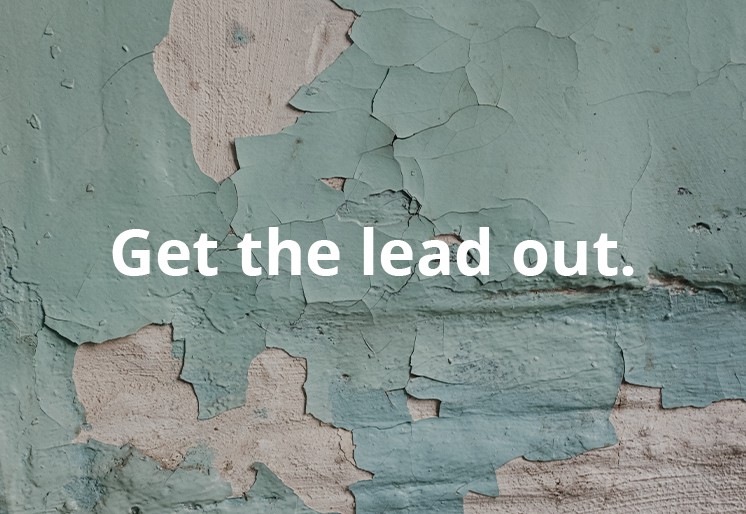As we close out June as National Healthy Homes Month, we are taking some time to recognize the decades long environmental health issue of lead poisoning.
So, what is lead?
Lead is a toxic metal that is naturally not found in the human body but is commonly used in our surrounding infrastructure. Lead has been used in buildings, water pipes, paint, gasoline, roads, and even in toys.
Lead is a neurotoxin that’s harmful to humans:
- There is no safe level of lead exposure
- Lead poisoning creates permanent cognitive and behavioral damage
- There are no effective treatments for lead poisoning
- Particularly harmful in children under the age of 6, as brain and nervous system are developing
- Cumulative, negative effects can be seen in adults

Lead is particularly dangerous to children because their growing bodies absorb more lead than adults do and their brains and nervous systems are more sensitive to the damaging effects of lead. Babies and young children can also be more highly exposed to lead because they often put their hands and other objects that can have lead from dust or soil on them into their mouths.
Where is lead commonly found in the home?
Lead can typically found in paint, dust, soil, and water.
- Lead-based paints and dust – Common in homes built before 1978 because lead paint was commonly used until 1978 when it was banned from residential use. When the lead paint chips, crumbles, begins peeling, or is disturbed by demolition/renovation, the resulting dust contains lead and poses a health risk. Lead paint was commonly used around windows, doors, stairs, and on floors making the paint on impact and friction surfaces common places for exposure.
- Soil – Soil may be contaminated if it is near buildings containing lead paint. Leaded paint on the outside of buildings may weather and cause lead contamination in nearby soil. Demolished buildings or vacant lots may also have lead in the soil, especially if lead-containing products were used in the once-standing property.
- Water – Lead-containing pipes were used until 1986. These pipes can wear down and release lead into the drinking water. Plumbing fixtures and fittings can also contain lead, if they were purchased before 2014. All these sources present a health risk.
- Workplace exposures and consumer products – Toys, jewelry, glazed pottery, and imported spices can contain lead. Additionally, Some common occupations and hobbies that come into contact with lead include: house painting/remodeling, auto repair, metal work/salvaging/welding, industrial painting, electronics repair, jewelry repair, casting fishing weights/bullets, stained glass crafting, shooting/reloading ammunition, ceramics, jewelry making, and golf club repair.
What can we do in our home to minimize exposure?
Make sure you have your child tested for lead at 9-12 months and again at 24 months! If you live in a home built before 1978, consider the following:
- Wet dust and wet mop floors, window sills, door frames and other flat surfaces on a regular basis.
- Consider abatement. Locate certified contractors who can safely remove the lead paint.
- Do not disturb paint on walls. Keep children away from chipping or peeling paint.
- Make sure children wash hands when coming from outside. Wash toys, bottles, pacifiers with soap and water weekly.
- Use cold water for drinking, cooking and making baby formula.
- Test your home for lead contamination in the water.
- Purchase an NSF-certified* water pitcher or faucet-mount filter to remove lead and follow instructions.
- Consider replacing the lead pipes. Contact your water authority for programs.
- NEVER boil water to remove lead — this may increase the amount of lead!
- Clean aerators in all faucets weekly by rinsing dirt from the screen.
- To avoid tracking soil into the house, put doormats at each entryway and wipe shoes well.
- Cover bare soil by planting grass, vegetables, or other plants.
What to do if your child has an elevated blood lead level?
Even low levels of lead in blood have been shown to affect IQ, ability to pay attention, and academic achievement. And effects of lead exposure cannot be corrected.
- A confirmed blood lead level of 5 micrograms/deciliter gets any child between 0-3 years old access to Early Intervention services and entitles the family to Allegheny County Health Department’s Lead Home Investigations program for a full risk assessment to identify source(s) of lead exposure and receive best practices to minimize risk.
- If your child is between 0-3, contact the Alliance for Infants & Toddlers by calling 412-885-6000 for more information. If your child is 3-5 years old, contact the Allegheny Intermediate Unit – DART program by calling 412-394-5904.
- The Allegheny Lead Safe Homes Program provides free Lead Risk Assessments, education, and up to $12,000 of interim controls and lead abatement services. Eligible families must: be homeowners or renters in Allegheny County, live in a home built before 1978, have a child under 6 who lives in or regularly visits the home OR a pregnant woman who lives in the home, and meet income limits.
- Allegheny County Health Department’s Safe and Healthy Homes Program(SHHP) provides a free visual inspection for lead-based paint as part of a home health and safety assessments. Household must include at least one pregnant woman or a dependent under the age of 22 and meet income requirements. Call 412-350-4048 to apply.
- Women for a Healthy Environment offers free XRF (X-ray fluorescence) testing of household/personal items such as toys, dishware or jewelry.
How can I take action?
Lead poisoning is 100% preventable and protecting our community from this invisible neurotoxin is possible when we act together.
Women for a Healthy Environment is involved with several platforms that provide the opportunity for community action on this issue. We coordinate and participate in a countywide coalition that develops coordinated primary prevention strategies and advocacy initiatives by convening local government agencies, community-based organizations and non-profits, managed care organizations, health care providers, lead safe contractors, lead safety trainers, early intervention specialists, and many others. We are also actively involved in the communications campaign “Get the Lead Out, Pittsburgh” that is shining a light on lead poisoning, helping families who are impacted, and enacting changes to make our community safer.
Creating lead-safe environments for children to live, learn, play and grow requires policies that prevent exposure from taking place altogether. The following policies have successfully protected communities from lead in localities across the nation:
- Rental registries of lead-safe properties
- Certified lead contractors
- Lead-safe demolition and renovation practices
- Total water line replacements instead of partial line replacements

Visit www.gettheleadoutpgh.org/action for tools on how to engage with your local elected officials, tell your story, and make these solutions a reality in our region.
If have any questions, please email our Healthy Homes Coordinator, Hanna, at hanna@WomenForAHealthyEnvironment.org.





